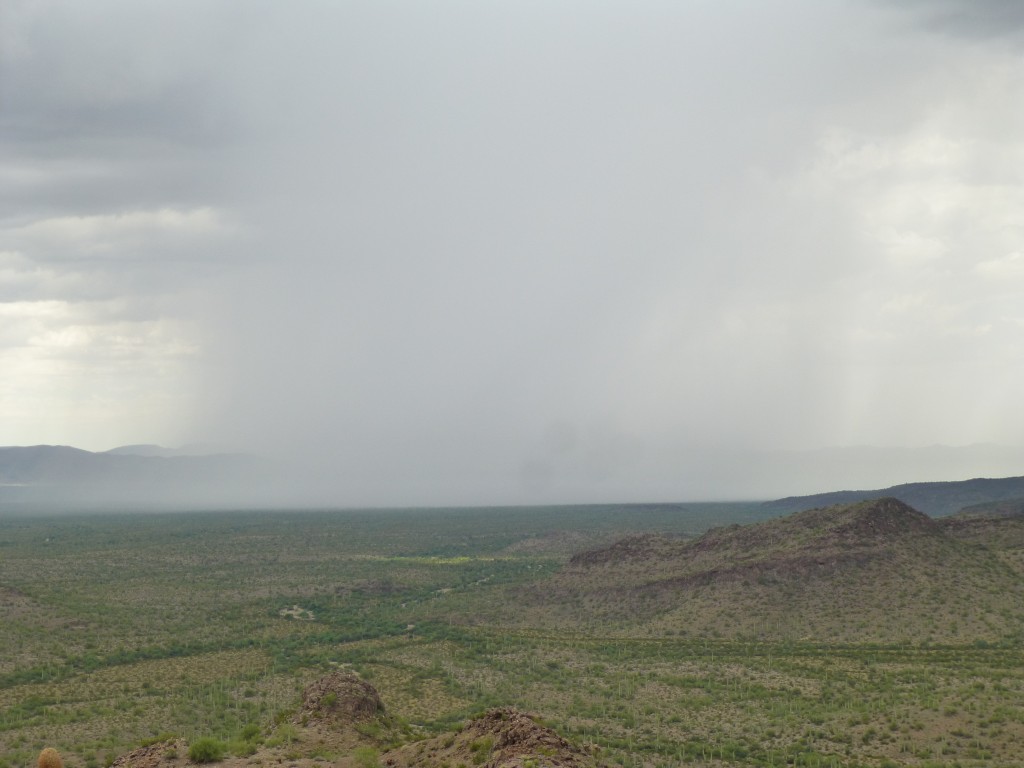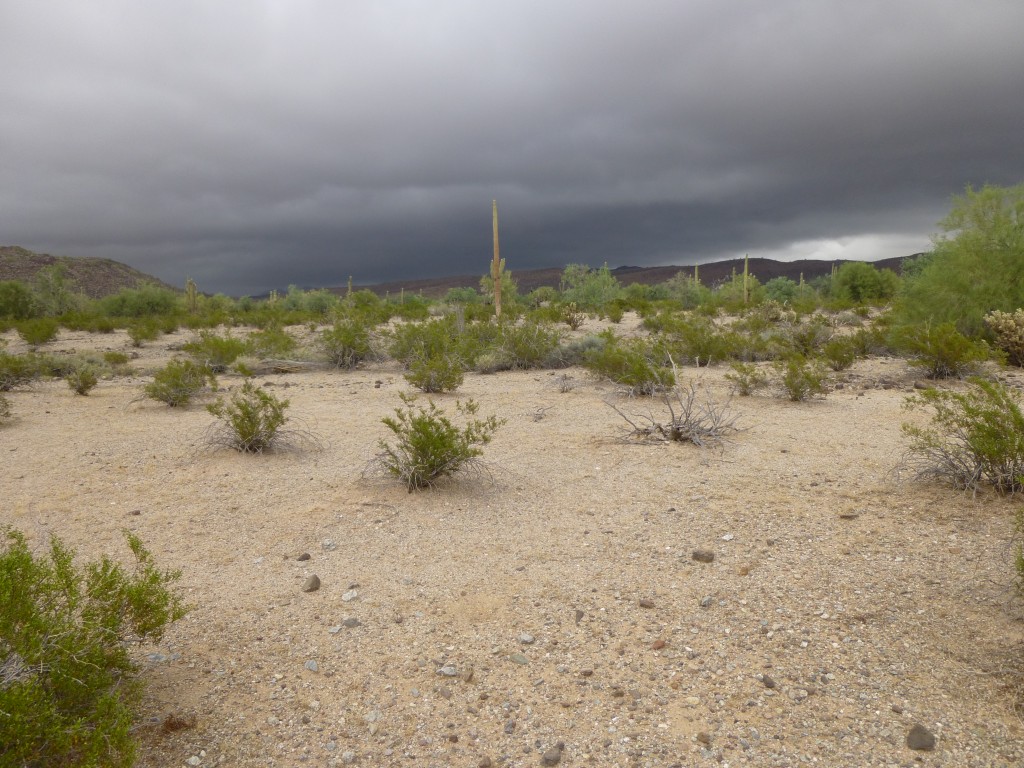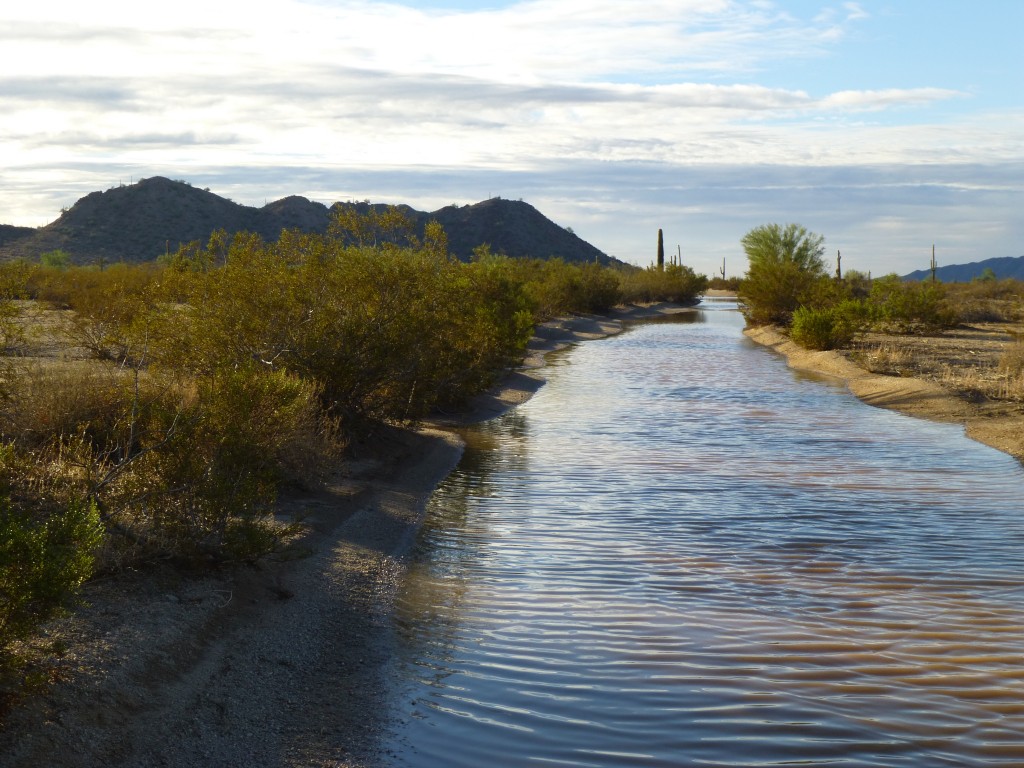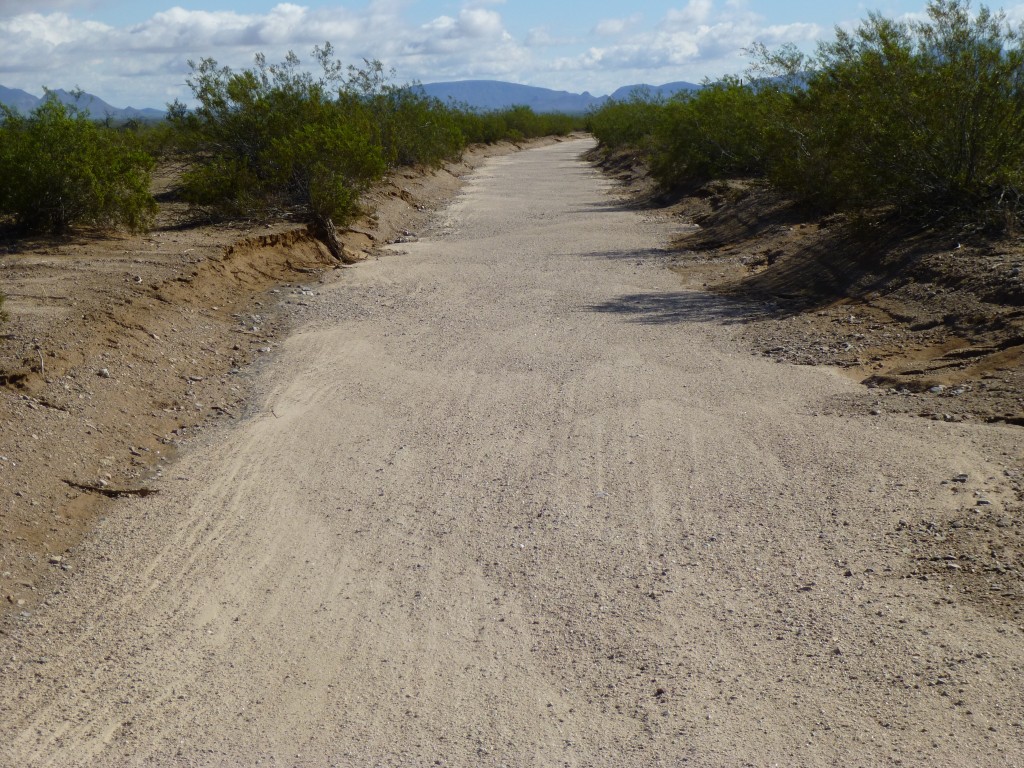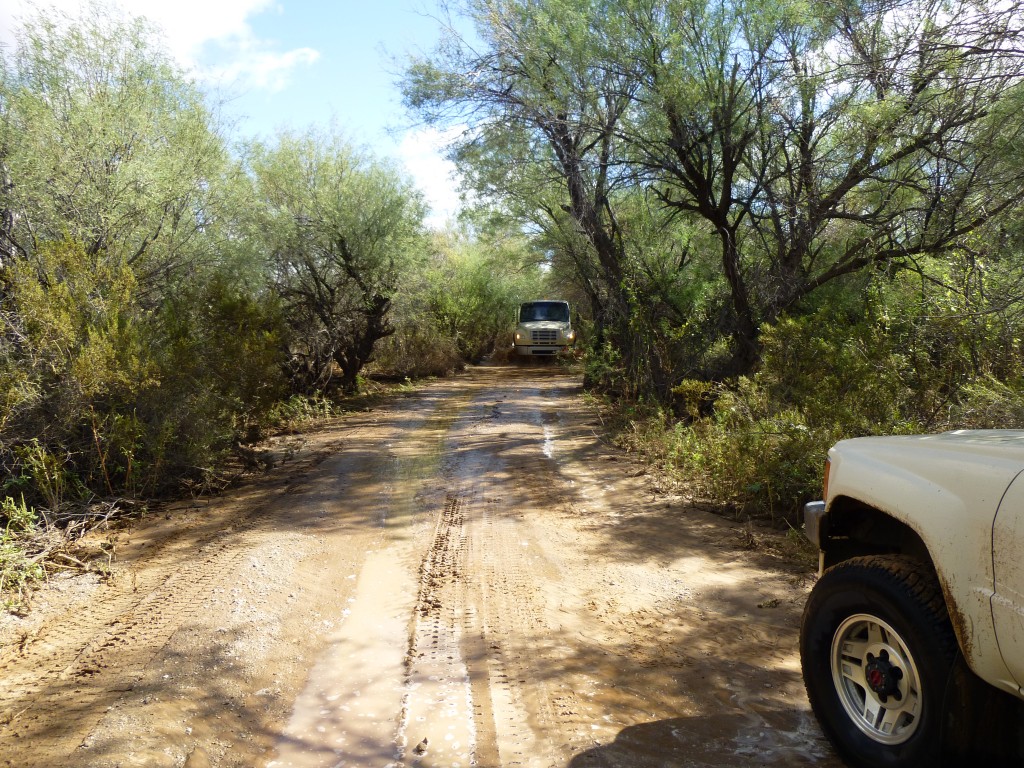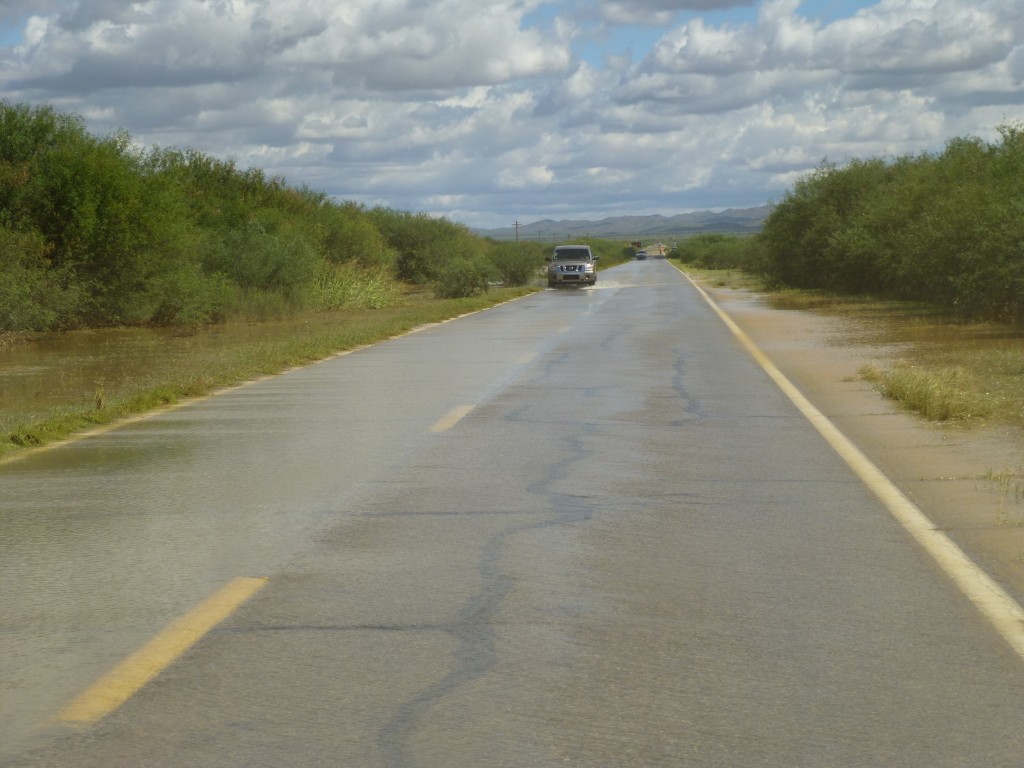Here in the Sonoran Desert, our late summer monsoon rainy season has been one to remember, one for the record books. In July and August, we had some good storms, bringing much-needed rain to our parched land. Normally, our monsoon season is all but over by early September, but this one broke all the rules.
At long intervals, residual moisture from Pacific hurricanes off of Baja California makes its way up to Arizona. But this year, 2014, not one but several of these storms have affected us. Usually, the hurricane itself spins harmlessly off to the northwest of Baja and dies a natural death out in the Pacific.
On September 8, rain from Hurricane Norbert hit the Sonoran desert. Phoenix saw major flooding, so much so that its effects were televised on the national news in Canada where I was visiting at the time. What didn’t make the headlines, though, was the tragedy that happened in my home city of Tucson. A woman’s car was swept away by water running across a busy street – it was pinned under a bridge and she drowned. In a separate incident during the same storm, a couple’s car was also swept away by fast-flowing water – he was able to be saved, but she lost her life.
Less than two weeks later, the remnants of Hurricane Odile reached us. I was out climbing in the desert with Andy and Jake for a couple of days. We set out one fine morning in the Sand Tank Mountains to climb a few peaks, and by mid-day our clear skies had evaporated. Dark clouds grew out of nowhere and the heavens opened. Man, did it rain on us, and hard!
By the time we got back to our trucks, water was sloshing in our boots. It rained for hours, quite a surprise for late September.
One week later, on the 27th, I returned to the same area to bag two more peaks. When I arrived in the morning, I had a clear blue sky. Atop the second peak, I noticed clouds building up, and very quickly. I barely made it back to my truck before it started to rain, and how!
In the 18 miles of rough dirt road leading back to blacktop, the rain came down harder and harder, so much so that I was afraid of getting stopped by fast-flowing water in the desert washes across my path. My luck held and I wasn’t delayed, but by the time I reached Interstate 8 at the town of Gila Bend, it was raining so hard that visibility was limited to a couple of hundred feet.
Once on the freeway and heading east, it only got worse. The rain was coming down so hard that my windshield wipers were useless. Freeways are engineered in such a way that rainfall runs off to the sides, but you wouldn’t have known it this day. I could feel my truck hydroplaning at times, and in order to drive safely I kept reducing my speed, so that eventually I was crawling along at 40 mph in a 75 mph zone. Even the truckers were going that slowly. The storm was of biblical proportions, and my white-knuckle driving continued for a full 50 miles. I finally outran it, but I could see in my rear-view mirror that what I had left behind was black as night. I thought I had it made, but the sunny skies ahead lulled me into a false sense of security. I would pass through three separate dust storms in the next 30 miles, two of which completely stopped all traffic. It felt good to finally make it home.
October had arrived, and I figured this unusual weather was finally gone for good. Now I could get down to some serious climbing without worrying about bad weather hounding me – or so I thought. A week off of work was all the impetus I needed to head out to the Cabeza Prieta, a vast chunk of pristine desert bordering Mexico. It started out innocently enough – I left Tucson on a Sunday, and when I camped after an afternoon climb, it was still 90 degrees. The second day was also hot, and surprisingly muggy – there seemed to be a lot of moisture in the air, and a hazy overcast had developed. By day three, more clouds were hanging around. I didn’t get rained on, but by day’s end it was completely clouded over. Sunset brought a few sprinkles – I could live with that, but the radio kept saying that another Pacific storm might send rain across my swath of desert. Four more peaks awaited my attention, so some rain was fine, as long as it wasn’t enough to ruin my chances of finishing those climbs.
As the night progressed, the rain came down in earnest. I lay there, listening to it drumming on the camper shell, drifting in and out of sleep. There was a total eclipse of the moon scheduled that night, but zero chance of seeing it. It just poured, for a full twelve hours straight, coming down so hard that I didn’t even get up to pee. Finally, I couldn’t stand it a minute longer and peed in my water bottle. It was after nine in the morning before it let up enough to step outside. My gear I had stowed on the ground under my truck was soaked, but I managed to scrounge enough together to prepare a pack for the day. It looked like the worst of it had passed, so at around ten I set out to climb two peaks. For the next four hours, I kept looking over my shoulder to see if any bad weather were coming, but my luck held.
The next day dawned with a lot of low clouds hugging the mountaintops, and fog on the desert floor for miles at a stretch. All I had left to do was to drive east for five miles to climb my last peak. As I started out on the Camino del Diablo, immediately I started seeing pools of standing water in the road. The ground had become so saturated from the overnight storm that there was no place for it to go, all it could do was sit there in the low places. I’d been visiting the area for 25 years, but had never seen anything quite like this. Puddles is too mild a word – these were real pools, some of them 20 to 30 feet long. I parked for my peak, spent a few hours climbing it, then continued my journey east along the Camino. Near Chinaman Flat, some of the pools were enormous – one stretched over 400 feet along the road, to a depth of at least 12 inches.
Something that I noticed was that there were no other tracks in the road; nobody had passed this way in the 24 hours since the storm had ended. This did not bode well. Another interesting thing I noticed was that many parts of the road which were normally rough were now completely smooth – the running water had moved all of the sand on the surface so that it was flat like it had been paved.
My biggest area of concern was the San Cristobal Wash, a place where many normally-dry streams cross the road over a distance of a full third of a mile. When I reached it, my fears were realized. Cautiously, I made my way through a few pools of standing water. So far, so good. Then, ahead of me in a narrow stretch of road closely hemmed in by thick vegetation, I saw something approaching. It was a large truck. Since the road was barely wide enough for a single vehicle, I backed up for a hundred yards until I reached a slight widening, enough that I could pull over and let him pass. The driver reached me and we talked.
He said that just ahead, where I had first spotted him, was the deepest pool of all. The truck he was driving was very large – where he sat, his head was a good eight feet above the ground. His truck had all-wheel drive and dual rear wheels. Even so, when I had watched him drive through the deep pool, his truck sank noticeably. He advised against my driving through it, suggesting I wait until the water level dropped. I thanked him and let him pass. Minutes later, a similar truck came through – they were tankers hauling water to Camp Grip, a remote Border Patrol station along the Camino del Diablo to the west of Papago Well, my campsite for the previous three nights.
Moments later, my decision was made – I’d decided to try to go through. Away I went, cautiously easing the truck into the pool. Dang, it was a lot deeper than I thought! Luckily, the bottom was fairly firm. The water came up to the bottom of my doors, a full 24 inches – if you don’t think that’s deep, go outside and measure how high up that is on your own vehicle. I was pushing a bow wave ahead of me as I continued, but I made it. There were many more pools, but that was the deepest. After getting through them all, I figured I was farting through silk, that I had it made. A short while later, I drove into a big, soft mudhole and bogged down below my axles – so near, yet so far! By some miracle, I managed to work my way out and continue. From there on, it was an easy drive to Boundary Camp, another big Border Patrol station along the Camino.
I stopped to talk to them, telling them, with full embellishment, all about my adventure driving from Papago Well. They declared they had no intention to make the drive until the flood-waters subsided. On I went, and 15 miles later I had passed all the way through the northwest corner of Organ Pipe Cactus National Monument. I then met Donnie, an officer from the U.S. Fish and Wildlife Service, who had helped me in the past in the Growler Mountains. He asked me to report the news of the flooding to the Cabeza Prieta headquarters in Ajo, which I did as soon as I arrived there. They were quite surprised to hear how bad it was, and immediately posted a notice on their website, advising the public to avoid driving the Camino del Diablo for the next 48 hours.
All of this moisture from Hurricane Simon showed itself once more on the way home. Driving east on Arizona Highway 86 through the reservation, I came to a stretch where flood waters were sheeting across the road for a full half a mile. Traffic was proceeding, but slowly.
The rest of the trip home was uneventful, and good thing, too – I’d had enough of hurricanes to last me a long while.
Please visit our Facebook page at: https://www.facebook.com/pages/Desert-Mountaineer/192730747542690

